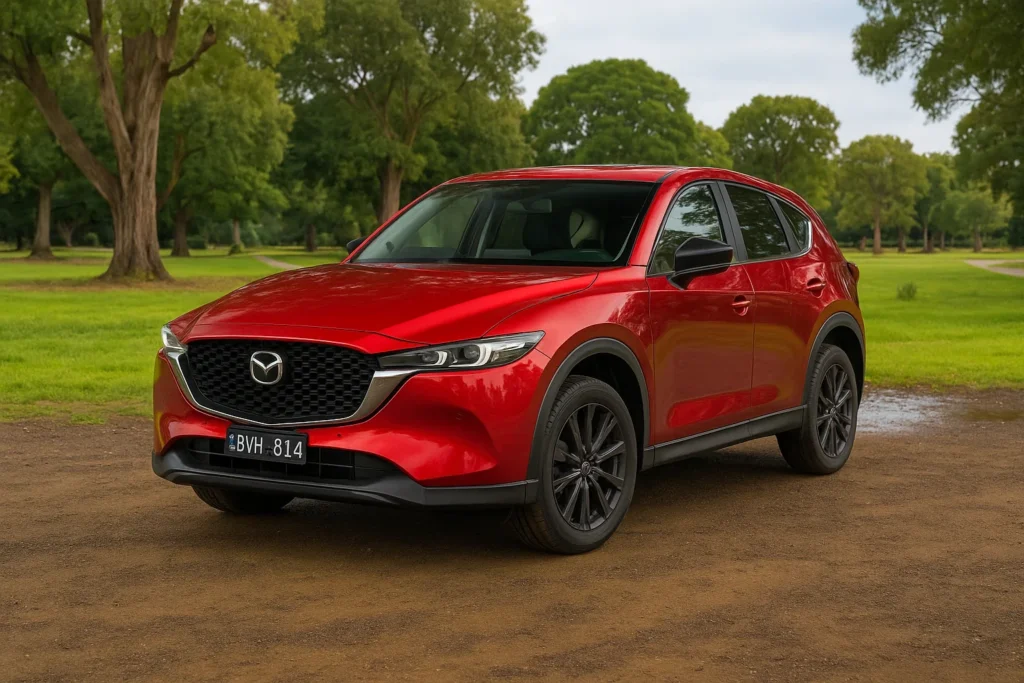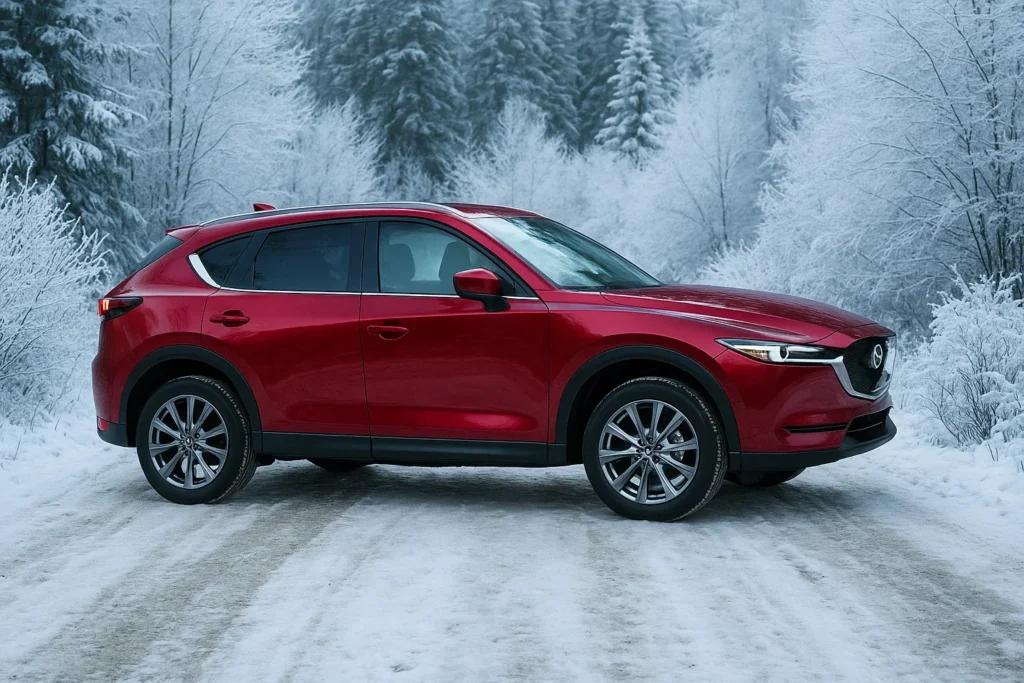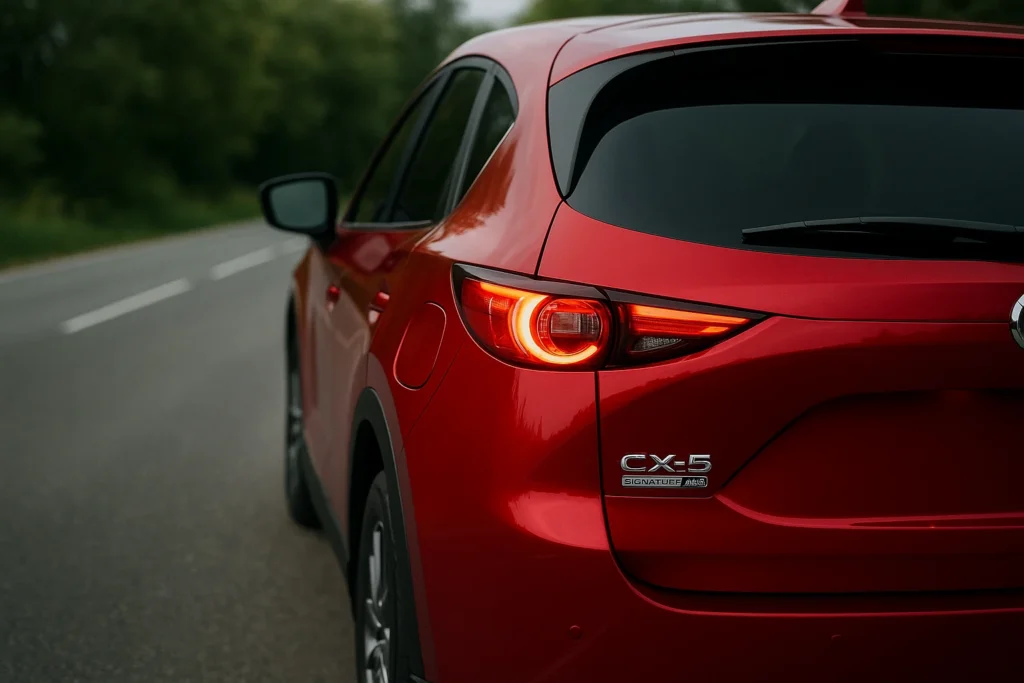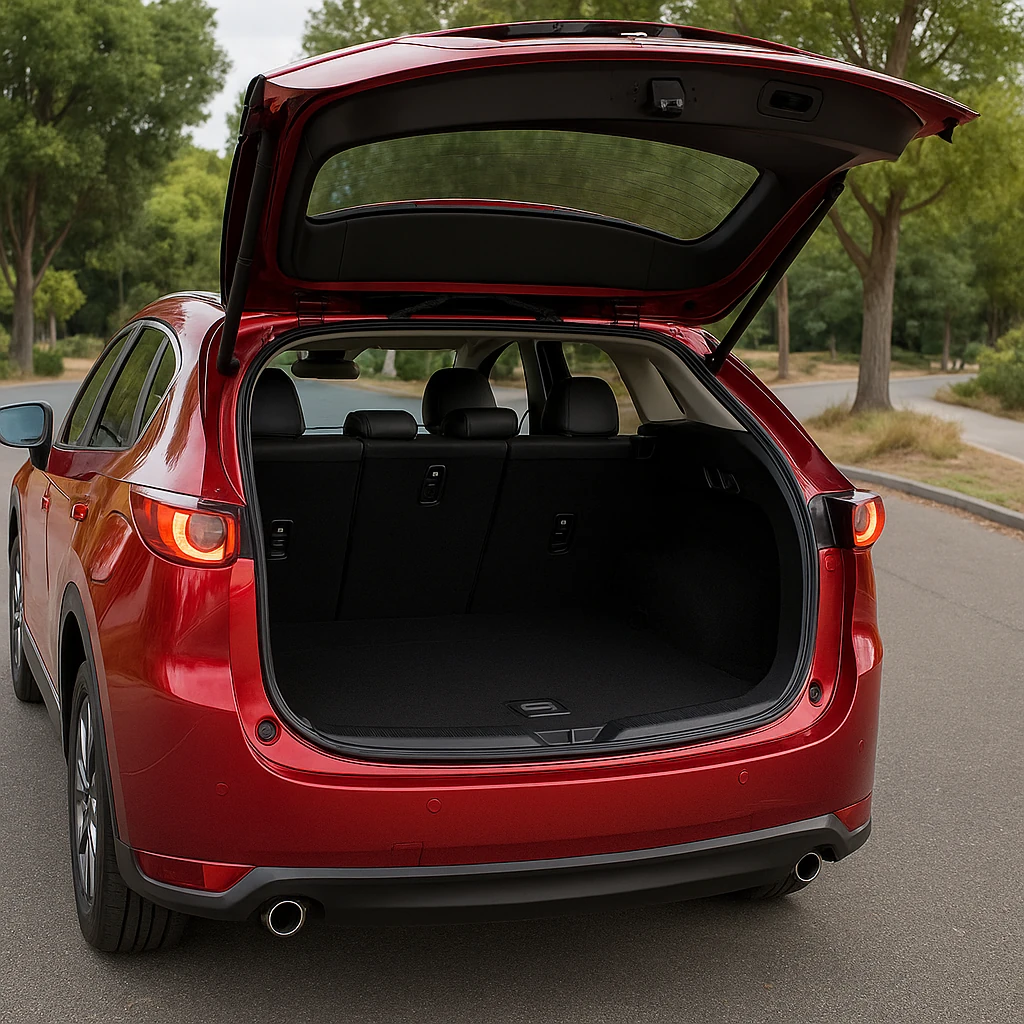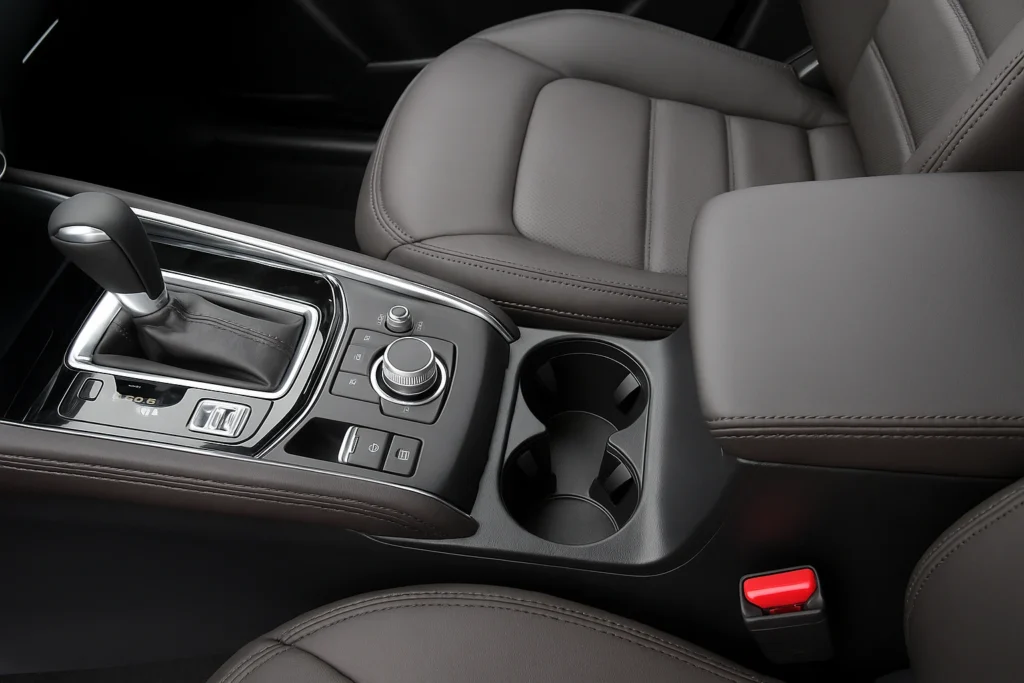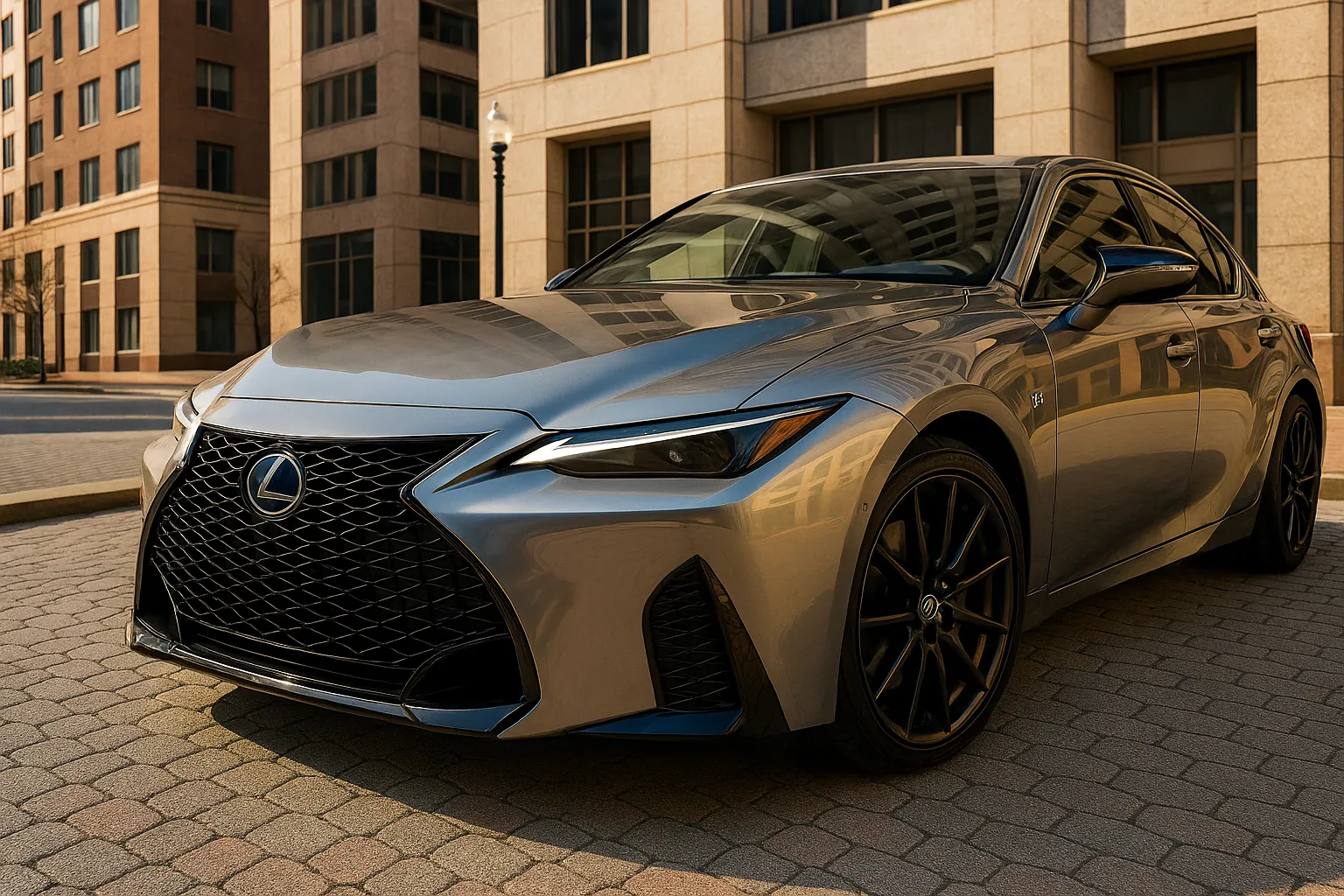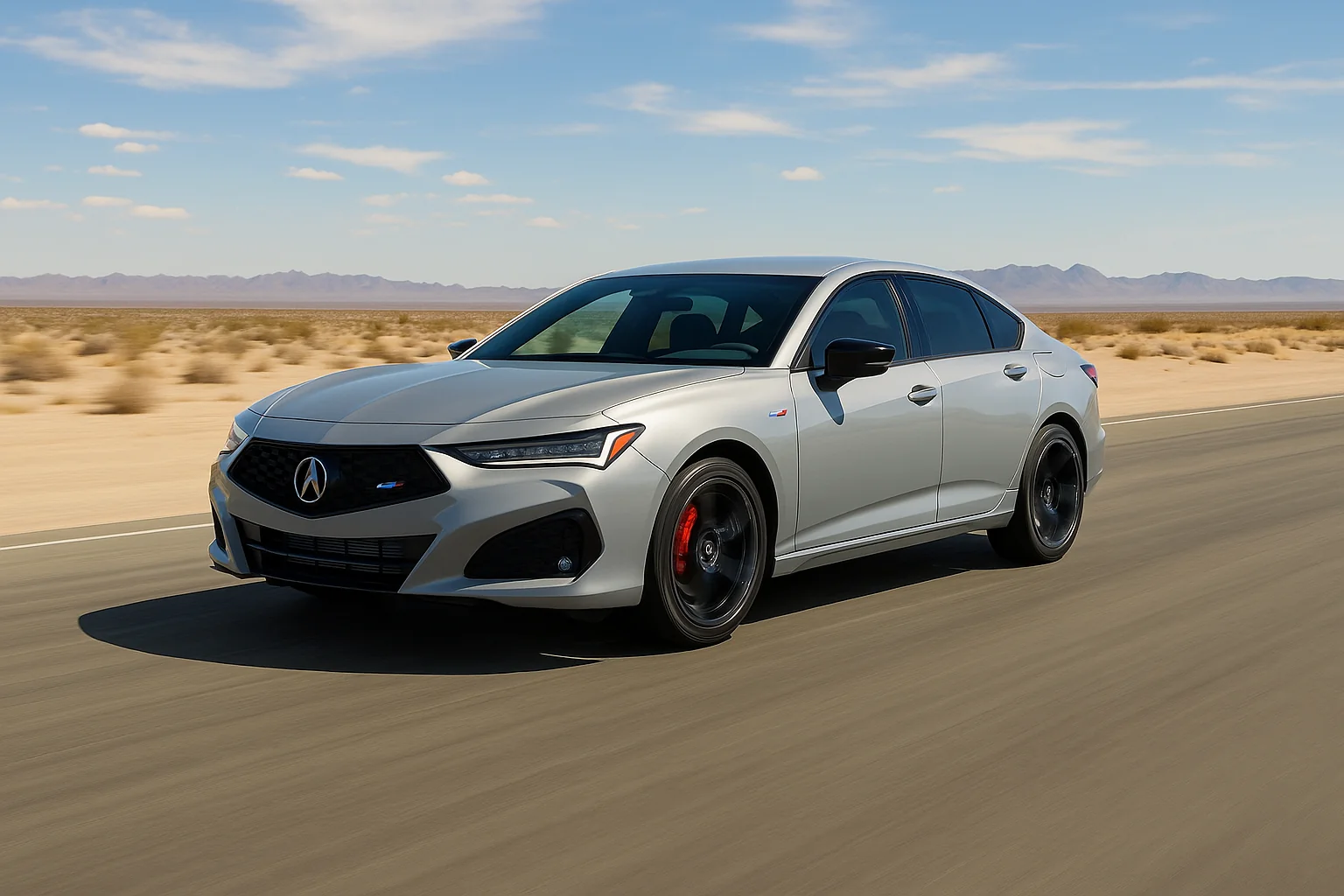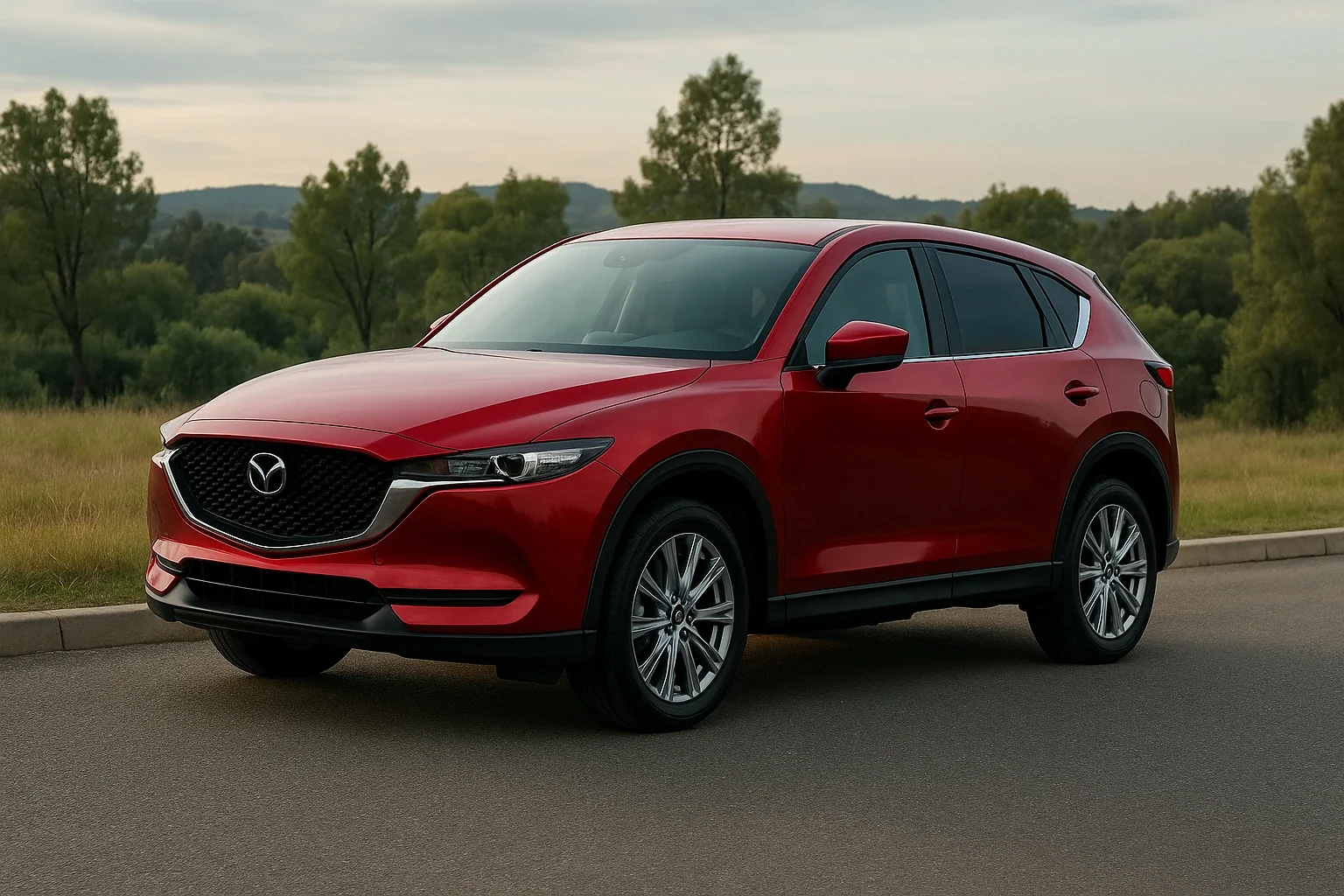
As-Tested: $41,655
8.2 /10
Rating
Pros
- Refined interior build quality
- Smooth and balanced handling
- Comprehensive safety features suite
Cons
- Average fuel efficiency rating
- Outdated six-speed transmission
- Limited touchscreen functionality
2023 Mazda CX-5 Turbo Signature AWD Review with Vyocar
The CX-5 Turbo isn’t loud or flashy—it’s just thoughtfully built for real drivers who value balance over boldness.
Overview
You know that moment when a crossover shows up looking like it’s about to serve Lexus RC elegance with a side of Mazda Miata agility… and then turns out to be just another compact SUV trying to flirt its way into the premium segment? Yeah, that happened. At first, the styled exterior and panache made me suspicious — the kind of attractive that screams expensive, but doesn’t back it up. But then came the test drive. And honestly? It was kind of brilliant. The turbocharged 227-hp engine brings just enough dynamics to feel lithe without trying to outgun an Acura TLX. Inside, the interior isn’t trying to impress your boss — it’s trying to impress you, the commuter, the urbanites, the suburbanites, the people with passengers to haul and a decision to make that doesn’t feel like a scam. Sure, the price has crept up, but this isn’t a bait-and-switch; it’s a quiet blend of utility, comfort, and manners. The CX-5 stays within the mainstream lineup, yet somehow avoids being another volume buyer’s default. Think of it as the alternative that finally nails the real-world satisfaction without abandoning the automaker’s reputation. And yes, it still trumps most small models in the States, even some redesigned ones wearing flashier naming gimmicks like CX-70 or CX-90. Is it an excellent breakdown of class conventions? Not really. But in a world of overpromises and overspending, this is a rare review where the CX-30 doesn’t feel like the better buy. Just don’t expect five seats of plush — it’s spacious, but still compact. That said, this car proves you don’t need to spend luxury money to get a compelling drive in 2023.
What’s New for 2023
At first glance, it feels like nothing changed — the headlight, taillight, bumper, and signatures look eerily familiar, like that one coworker who insists their 2017 haircut is still “in.” But spend a second walk around the showroom, and the subtle facelift reveals just enough new swanky tweaks to keep the generation alive. The 2023 models gain a Rhodium White paint option, some barely-there front and rear nudges, and yet, the lineup feels unchanged — especially for those expecting a significant jump. Still, compared to its similarly-sized CX-50 sibling, it doesn’t try too hard to scream for attention, which oddly makes it more appealing. It’s like Mazda introduced a midlife crisis and then decided, “Eh, we’re good.” You still get the same optional upgrades, same Metallic finishes, same weird rivalry with itself, and the same question: is this still worth selling next to flashier crossovers in 2024? Depends how long you’ve been holding on since 2022.
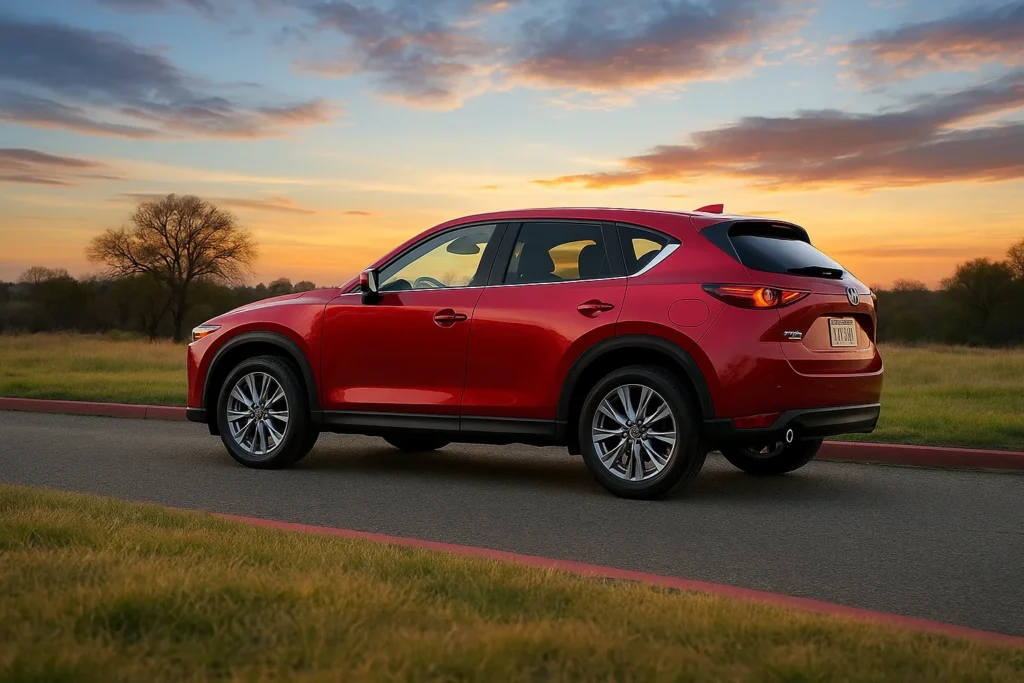
Pricing, Trim Levels, and Best Pick
Looking at the As-tested price: $41,655, my first thought was, “Ah, so we’re pretending to be luxury now.” But the CX-5 Turbo slowly justifies it, especially in 2023 with the trim-specific upgrades that don’t scream for attention, but whisper sportiness through red stitching, gloss-black mirrors, and subtle exterior accents. The interior feels well-put-together—not overdesigned, not cheap—just balanced. The 227-hp turbocharged engine delivers enough quickness and handling to back the sporty look without pretending it’s something it’s not. This isn’t a performance car; it’s an athletic, everyday crossover that quietly exemplifies what Mazda does best. Out of all the options, this upgraded trim is the best pick if you care about feel more than flash and want a Turbo that actually earns its badge.
Powertrain, Transmission, and Driving Dynamics
If stonking performance is your norm, the 2.5L turbocharged mill might initially feel like a letdown. On regular 87 octane, you’re working with 227 horsepower, which delivers a 0-60 in about seven seconds — not exactly glacial, but quicker with 93. On paper, it’s upmarket, Turbo, even Signature-grade. In motion, though? It’s a mixed bag. The CX-5 puts out respectable torque, but there’s a pause, a lag, and then a sudden move once the revs catch up — a pattern I know all too well from years of bad cardio decisions.
The six-speed automatic (yes, still a six-speed) doesn’t scream modern, especially compared to an eight-speed, but it’s smoother than most competitors and works decently well with the AWD (or all-wheel) traction system. G-Vectoring adds just enough intervention to modulate weight across curvy routes without overwhelming you with coarse corrections. Steering is well-weighted, nimble, and gives just enough feedback to keep things engaging—nothing soft, nothing overly touchy, and no dull dead zone like some competitors in the segment.
On an uphill loop, you’ll notice the chassis keeps its composure under speed, and while the braking methods are mostly standard, they apply predictably with minimal fade. The pedals, though, can feel touchy at low speeds and strangely grainy when trying to modulate in traffic, especially during lugging down moments. Still, compared to the cost, it’s a decent gain for the brand, one that reflects years of trial, test, and quiet excellence by Mazda’s engineers in Japan.
Now, about fuel economy—it’s decent, not class-leading. But this model wasn’t driven to win a miles-per-gallon trophy. It was built to deliver proper performance with just enough damping and standards to meet the feel of an enthusiast-lite crossover. Think of it as an indicative answer to the Volkswagen Jetta: a CX-5 that tries harder, maybe too hard, but still manages to hit the point. And if the braking or tires let you down, just remind yourself — you didn’t buy this to beat a Ferrari. You bought it to beat traffic without losing your soul.
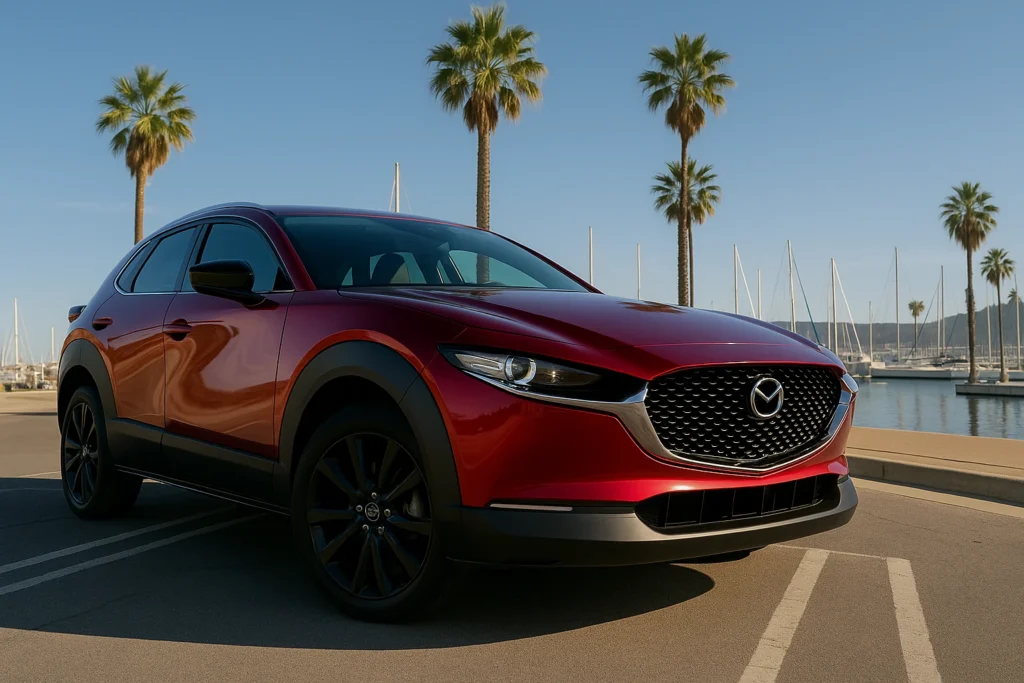
Towing and Payload Capacity
I wasn’t expecting it to tow anything serious — maybe a small trailer, maybe my trust issues — but when optioned with the turbo engine, it actually tows up to 3500 pounds, which is a solid improvement over the standard 2000-pound capacity. That puts it ahead of several competitors, including some larger ones from Volkswagen, and not far behind what the flashier CX-50 brags about. For a crossover, the trailering capability feels like Mazda quietly showing off — not flashy, just functional. It’s not a truck, but it knows how to pull its weight when asked, and sometimes that’s more than you get from others pretending to be rugged.
Fuel Efficiency and Real World Testing
I checked the EPA claim before my week-long trip to Bakersfield and Long Beach, and I knew the CX-5 wouldn’t sip fuel like a Hybrid, but I didn’t expect to need a personal gas dashboard therapist by day three. Across 297 miles of urban, highway, and suburb routes, with passengers, luggage, full AC, and an AWD drivetrain, my real-world consumption averaged 25.3 mpg — better than the claimed 23 mpg combined under city conditions, but well below the 30.2 mpg you might dream of if you’re used to a Toyota RAV4 Hybrid or Hyundai Tucson. The 6-speed automatic transmission held its own, but in traffic, it felt a bit slow, and throttle response under normal mode wasn’t exactly Sport-ready.
Still, steering was smooth, and tuning across the chassis, gears, and hood felt genuine, if not spirited. I did a calculated evaluation with receipts and gallons used, even logging my usage down to 11.7 mpg during an occasional LA loop in heavy traffic, which made me question my life choices more than the Mazda. I also tested a manual mode, which offered some craving-satisfying control, though the tuned programming still favored steady inputs over fast shifts. In FWD trims, I’ve heard it’s slightly more efficient, but this trim with turbo, AWD, and my very real craving for A/C drama made that impossible to verify.
Compared to its 2024 counterparts, the CX-5 isn’t the most practical for everyday fuel saving, especially for folks hunting for Hybrid-like gains. But it’s an honest effort in a segment flooded with fake promises. The tuning, while repeated enough times to become a spiritual mantra, is what holds it together—it’s been tuned, re-tuned, dropped, tuned again, and yet the actual result is something that feels intelligent, better than average, and avoids being dragged down by dry, middle-of-the-road charts. In short: it’s no cruise-control king, but it is a car that gets you there—full of movement, if not optimism.
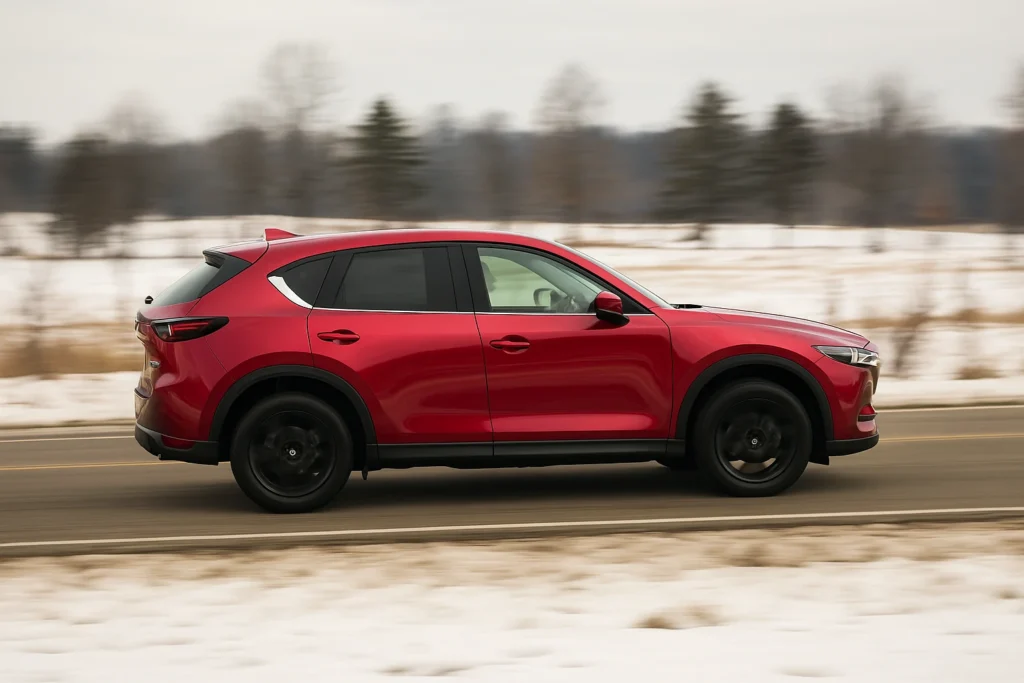
Interior and Comfort
The first hour inside felt a bit underwhelming — maybe it was the flimsy tailgate button or those cheap plastic mouldings around the shift lever, but I expected more. Then the Turbo trim kicked in, and so did the pleasure. The genuine Nappa leather chairs—brown stitched, supple, and comfy—are a delight to behold, with enough lateral support to keep you from falling into the bottoms on fast backroads like Curves near Le Mans. The front seats are shaped for long-distance driving, not just padded for soft cushy effect, and the rear bench—while a bit flat in the middle—still gives decent legroom, even for adult, tall folks sitting outboard.
The seatback recline is just enough to stay comfortable, not numb, and even though the windows feel narrow, the view from the elevated position gives you that “I’ve made it” feeling, or at least that “I’m above the Prius” comfort. The driver-oriented controls are within reach, and every button and switch has a clean, restrained feel—not flashy, but classy and clearly built with Mazda’s typical attention to detail. The piano black, gray wood, and subtle chrome finishes push it into near-luxury grade, easily trouncing the efforts of Toyota and Honda in this class.
On the highway, the ride quality holds strong. It’s firm enough to avoid that floaty mess you get in some competitors, yet soft enough to absorb bumps and imperfections without turning the cabin into a drum. Even at high speeds, the noise stays down, and you can talk at a normal voice level — not always the norm in this segment. The CX-5 truly drives with strength, shaped by Mazda’s clear understanding of craftsmanship and materials. The powered tailgate is quick to close, the doors lock with a satisfying click, and even the backup camera has crisp resolution with no lag. Blind spots? Sure, the pillars are a bit thick, but the system helps.
Inside, everything from the sculpted seatbacks to the Premium Plus Package trims feels like it belongs in a Porsche, or at least someone pretending they own one. It’s not the lowest possible luxury, but it’s high on the comfort scale, with support in all the right places, especially shoulder and bottom. Some parts feel hard, small, maybe even sharp at the edges, but nothing that makes the car feel cramped. It’s a model that quietly reminds you why Mazda still matters.
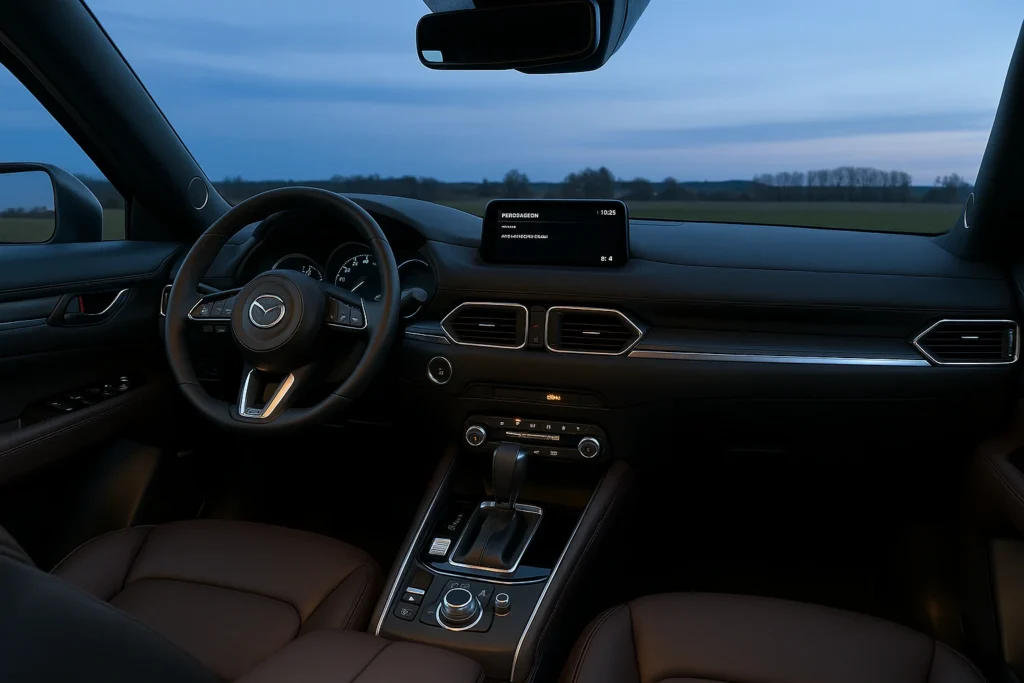
Cargo & Practicality
It didn’t start well—the plastic floor felt basic, the opening looked shorter than some competitors, and I was ready to write the whole cabin off as another pretty-but-useless vehicle. But then I actually started using it. Fold the rear seats, and suddenly the space feels abundant, with enough volume to swallow a six-drawer dresser or a few overpacked suitcases (ask me how I know). The seatback tethers, anchors, and slots for tethering items show real thought—especially when kids are in the car. The liftgate rises high enough for decent access without impeding visibility, and the maximum capacity competes well, even if RAV4 and Honda Passport edge it out on paper. Still, it’ll accommodate your gear with utmost ease, and the cover helps conceal valuables from outside view. Bonus: the load height is low enough that you’re not pulling a hamstring every time you toss something inside, though don’t expect a portal to Narnia—just a smart, functional cargo area that gets the job done.
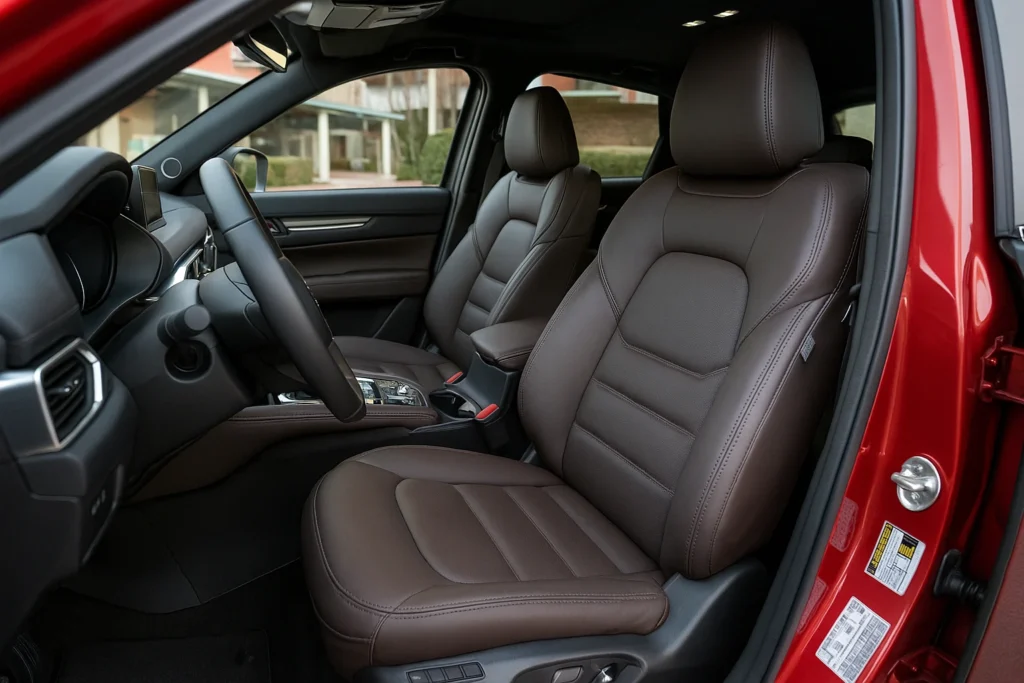
Tech & Connectivity
Initially, I was expecting a high-end tech experience—something smooth and intuitive—but instead got a mixed bag of iDrive-style frustration layered over Mazda charm. The 10.25-inch display looks nice when the vehicle is parked, but the UI isn’t exactly easy to use, especially with that infamous knob control that feels like solving a puzzle just to change terrestrial radio stations. There are physical shortcuts, which help, but the absence of a touch screen when running is a decision only Mazda and maybe a Volkswagen Atlas interior planner could defend. Natural speech recognition is hit or miss—I once said “call home” and it tried unlocking the tailgate—and the voice control tends to ignore people unless they speak with courtroom clarity.
The head-up display and blind-spot monitor are smart systems, though, especially when passing vehicles or receiving turning instructions. One nice surprise? The proximity key system that lets you unlock the door just by having the fob in your pocket, with a subtle clicking sound from the handle-mounted sensor that doesn’t scream “I’m opening now.” In fact, most of the beeps, bongs, and that weird low-pitched buzzing sound from the engine area are thankfully subdued—Hyundai Tucson, take notes. Aesthetics wise, the screen looks sharp, especially in low light, and doesn’t overwhelm the interior like some Genesis setups do. It’s not perfect—sensitivity of switch behavior could use a grace period—but in a scenario filled with overcomplicated tech, this setup finds some usability balance without completely dinging your patience.
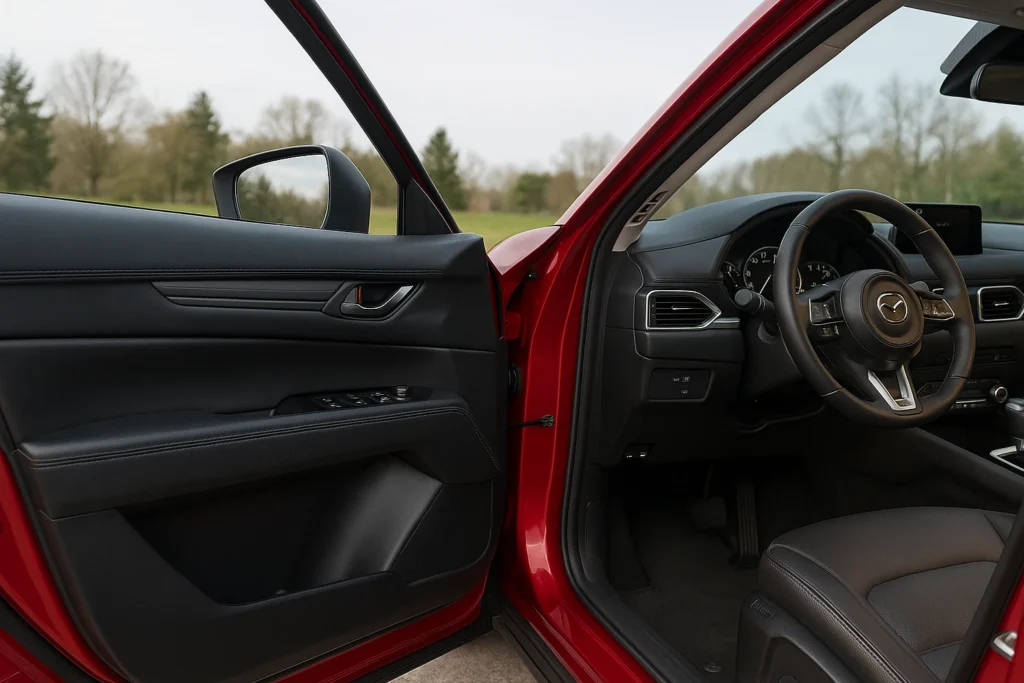
Safety
The display of all that driver-assistance technology felt overwhelming — lots of icons, warning chimes, and automated things trying to steer like they’ve known me longer than I know myself. But once I settled in, the adaptive cruise control, lane-keeping assists, and pedestrian detection started to feel less like nagging and more like actual guiding features. The Turbo trim brings a comprehensive suite, including a crisp 360-degree camera, backup view, and overhead perspective that honestly helped me avoid denting someone’s mailbox (again). Crash-test results are strong too—top ratings from both IIHS (Insurance Institute) and NHTSA (National Highway Traffic Safety Administration), which means it isn’t just safe on paper. The emergency assist system, lane-departure warning, and Traffic control tech are all standard now, and while some features are optional, even the base setup feels more thoughtful than most in this class. It’s not flashy, but it doesn’t need to be—it just needs to work. And here, it quietly does.
Warranty and Maintenance Plan
This is where the enthusiasm cooled a bit—Mazda offers a three-year, 36,000-mile limited warranty and five-year, 60,000-mile powertrain coverage, which, frankly, just meets the segment standard. It’s solid, sure, but when Hyundai and Kia are handing out longer plans like Halloween candy, you start to wonder why some automakers still think average is enough. Also, no complimentary maintenance, so those scheduled maintenance visits? All on you. For a brand that nails driving feel and build quality, this feels like a missed opportunity to show real long-term confidence in its product—or at least match what other smart coverage plans already offer.
Final Verdict
The truth is, I didn’t expect much—just another mainstream crossover with a drab-looking design and a glaring issue or two hiding beneath a shiny image. But this Turbo version quietly flips the script. It may not have a panoramic sunroof or superlative electronics like a Volvo XC60, and sure, some compromises in space and towing strengths exist. But for buyers who actually drive their car—not just project a lifestyle—the CX-5 feels genuinely nice, crafted with the kind of refine-ment that makes daily driver life more bearable. Compared to the CX-50, it’s lower, less flashy, but easier to interact with and less complicated. While Toyota RAV4 and Volkswagen Atlas lean on bulk and price, this one just quietly improves what it does best—being an honest-to-god solid car. It’s not trying to be luxury, but the interior hits near-luxury vibes, and that alone makes it an ideal pick for users who appreciate comfort over gimmicks. In a field of crossovers that struggle to balance looks with cost, this might just be the best Mazda to date—and the rare one that gives compelling reasons to skip the CX-9 altogether.
More images of the 2023 Mazda CX-5 Turbo
